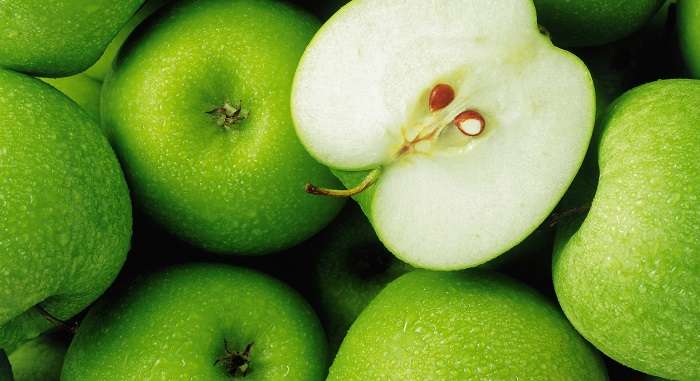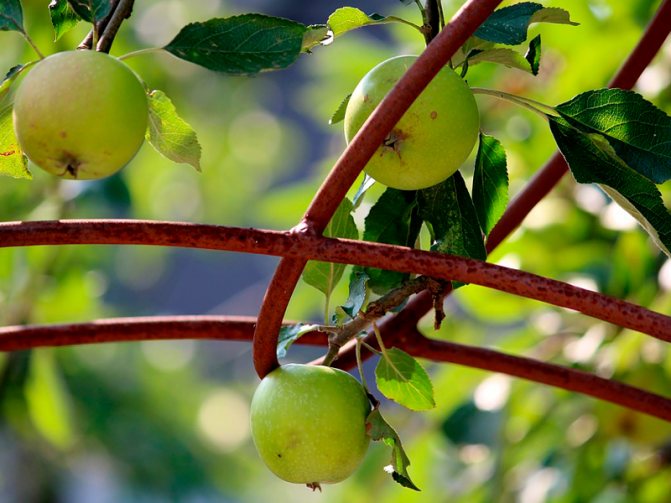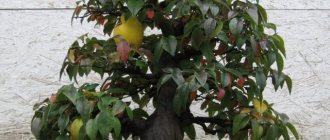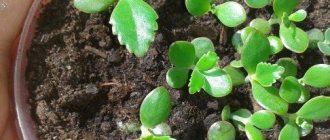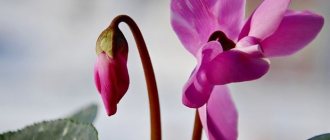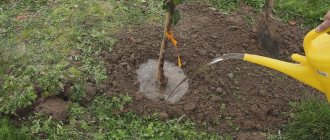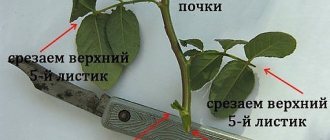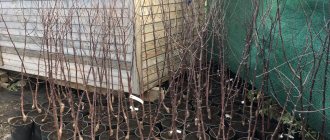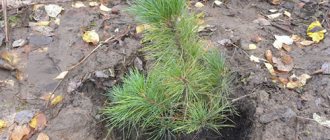- Primary landing
Growing fruit trees, especially apple trees, is a long and painstaking process, the success of which largely depends on the quality of the planting material. Many gardeners prefer to take seedlings from nurseries, but it often happens that the fruits bought at the market or in the store are tasty, and their variety is unknown. Not everyone knows whether it is possible to grow apple trees from seeds and how to do it correctly. We suggest that you familiarize yourself with a detailed description of all stages of the technology.
In nature, plant reproduction occurs generatively, by self-seeding. Many gardeners sprout seeds directly in the open field to obtain rootstocks.
Is it possible to grow an apple tree from a seed at home?
The cost of high-quality planting material in nurseries is not acceptable for every gardener, so many are thinking about germinating apple trees from seeds that are always available. However, this process is time-consuming, so if you need to quickly get a seedling, this option is not suitable.
Did you know? Of all the fruit plantations on Earth, 5 million hectares are planted with apple trees. Almost every second fruit crop is an apple tree.
In addition, the procedure and its effectiveness have their own nuances. The first difficulty of the procedure under consideration is that far for each seed will sprout. The second nuance is the fruiting of the resulting specimen.
It is important to understand that an apple tree grown from a seed very rarely adopts the quality indicators of the parent plant and in most cases yields a crop with reduced marketability and taste characteristics. To get a healthy fruiting apple tree, you need to choose the right variety, and vaccinate at a certain stage of growth.
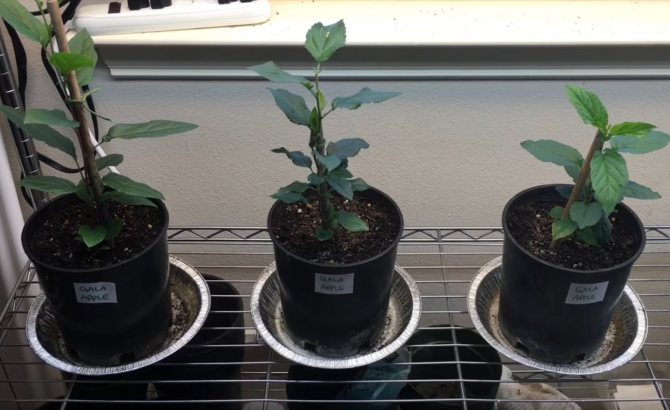
The advantage of such an event is to obtain disease-resistant, productive trees, the life of which will be at least 40 years, in contrast to purchased seedlings. The main thing is to fulfill all the requirements and create favorable conditions for growing sprouts.
Apple seedlings care
Germinating seeds is only the first step towards planting a real apple tree grown from seed at home. The next step will be work aimed at preserving seedlings and growing full-fledged seedlings from them.
Watering and feeding
When cultivating seeds, the soil mixture should be of constant moisture, therefore it is better to water it twice daily: in the morning and in the evening. After receiving shoots, by the time four leaves appear, watering is gradually reduced to weekly. Further, until the seedling reaches the age of one year, it is watered every 7-10 days.


Apple tree seedling.
In addition to regular watering, seedlings need nutrients. For feeding, infusion of humus or humic fertilizers are widely used. In the first years of the seedlings' life, it is not recommended to use manure or chicken droppings for feeding. Application of these organic fertilizers can cause burns on young plants.
Before wintering in the open ground, it is also recommended to fertilize the soil with potassium phosphate fertilizers.Mineral dressing is applied directly to the soil surface, spilled and shed.
Seedling transplant
Regardless of the purpose of growing apple seedlings, it is better to transplant a seedling to a permanent place when it reaches the age of one. If the seedling is intended to obtain a rootstock, then when transplanting, it is necessary to pinch the main root in order to form a more branched (fibrous) root system.
Cultivated seedlings are transplanted to a permanent place in the fall or spring at times determined by the weather conditions of a particular region.
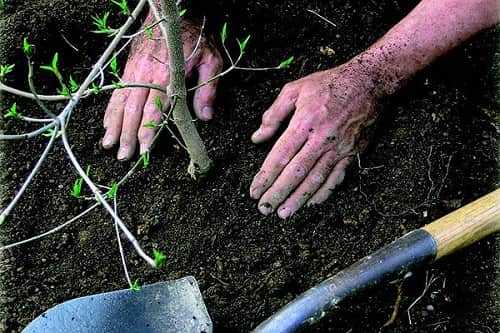

Transplanting an apple tree seedling.
Planting an apple tree that was grown from a seed independently is, of course, a great event for an amateur gardener. Such an apple tree will give a lot of joy if it bears fruit with varietal apples. So don't be afraid to experiment. In any case, you will not waste your time: if the wild grows up, it will become an excellent stock for grafting a cultivated apple tree.
Selection and preparation of seeds
First you need to pick a variety. According to Michurin's classification, there are 3 groups of varietal plants that differ in the quality of transmission of genetic information to offspring. So there are varieties that are capable of transmitting their qualities to offspring in full, provided there is no cross-pollination with wild animals.
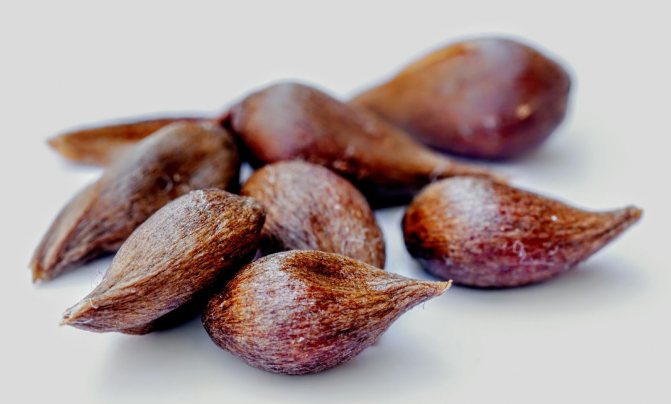

This group includes almost all large-fruited Chinese women, Antonovka, Muscat, Skrut, Pineapple white. The second group includes plants with an unstable ability to transmit genetic information to offspring - Babushkino, Grushovka, Borovinka. The third group includes varieties that, without observing certain conditions, are capable of transmitting genetic information - Renet green, Anis, Vorgulet, Saffron Pepin, Volzhskaya Turnip.
If the task is to grow a good cultivar without grafting, it is better to give preference to seeds from the third group. If you need to grow a well-known variety, then first you should prepare a frost-resistant wild game, and graft a cultivated variety on it.
When choosing seeds, you should pay attention to their maturity. They should be dense, evenly colored brown. You need to remove the seeds carefully so that they are not damaged.
Important! To avoid wasting time, always prepare about 5-10 seeds - after germination, only the strongest specimens will fit for planting, the rest will have to be thrown away. If you germinate only 1 seed, there is a great risk of not getting planting material at all.
Washing
After removing the seeds from the fruit, the inhibitory layer that prevents germination must be washed off from them. To do this, warm water is collected in a glass. Liquid temperature - + 35 ... + 37 ° С. Then the selected seeds are placed in it and stirred for 5 minutes with a wooden spoon or stick. Then the water is drained using cheesecloth or a sieve. The procedure is repeated 3-4 times.
Soak
The next stage of preparation involves soaking in warm water (+ 35 ° C) for 3-4 days. The container must be constantly kept warm and the water must be changed daily to avoid decay of the planting material. The air temperature in the room must be maintained within + 27 ° С.


On the third day, a growth accelerator should be added to the changed water. For this purpose, you can use "Epin". Add 3 drops of the preparation to a glass of water (100 ml). After 12 hours, the water is drained and proceeded to the next stage of preparation.
Stratification
The stratification process is not necessary - germination can be carried out at room temperature. But, it is an imitation of natural conditions and hardening, which contributes to obtaining high-quality specimens resistant to negative factors. In this regard, it is better not to give up the procedure.
Did you know? In heraldry, apples are a symbol of peace.
Stratification is carried out according to the following scheme:
- Mix sphagnum moss, sawdust, peat and sand in equal proportions.
- Add 2 tablets of crushed activated carbon to the mixture.
- Mix the resulting substrate with seeds in a 3: 1 ratio.
- Place the entire mass in a low, oblong container.
- Pour the contents of the container with warm water (+ 30 ° C) until it begins to ooze from the drainage holes.
- Incubated for about a week at room temperature.
- After a week, move the container to the refrigerator door or to the cellar, the main thing is that the air temperature is maintained within + 6 ° C.
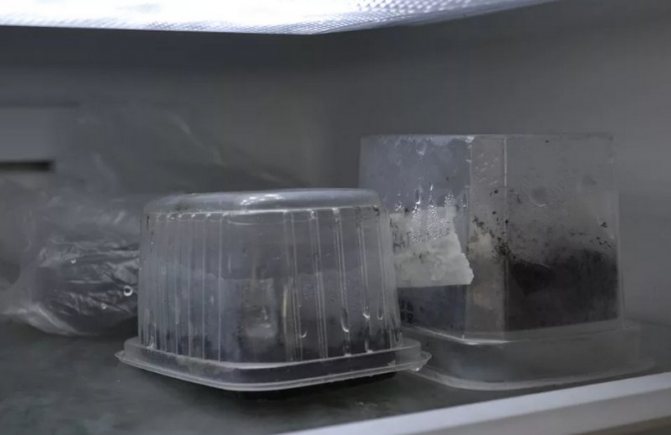

In the coolness, the seeds are kept from 60 to 90 days, depending on how many days the sprouts will appear
Let's summarize
Now you know how to grow a whole apple tree from tiny seeds, how to recognize a wild game and what principles to follow in germinating seeds. Enough theory, now get down to practice, acting according to our algorithm of actions. Do not doubt the success of your event, and you will achieve the desired result with a little effort and discipline. You can proudly tell your children in ten years that you grew that gorgeous apple tree in your backyard from a tiny seed.
Sowing technology: how to plant an apple tree from a bone at home
After stratification, you should examine all the shoots and select the strongest ones. Prepare a wide box or container with a large number of drainage holes according to their number. At the bottom of the container, 2 cm of expanded clay and perlite drainage is placed. It is better to use black soil as a soil mixture for germination. It contains all the essential nutrients.
Add to the soil for each kg, 100 g of wood ash and pour it with 1 liter of water with the addition of 1 ml of "Epin". Soil moisture should be about 60%. Then the soil is mixed well and placed in a container.
Also check out how to make an apple tree blossom and bear fruit.
Instructions for planting seeds for germination:
- Make markings in the box with a wooden stick - leave a step of 20 cm between the rows, keep a distance of 3 cm between the seeds.
- Make the indentations for the seeds no more than 2 cm.
- Place the seeds in the indentations and cover them with soil.
- If the soil is not moist enough, you can water it with a fine spray gun.
How long seeds germinate depends on environmental conditions. To speed up the process, you can cover the container with glass and put it in a warm place until the sprouts are biting. In this case, the room temperature should be kept within + 25 ° С.
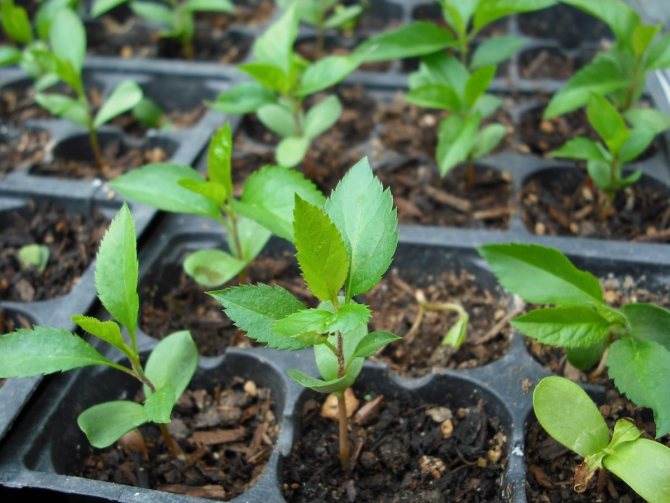

You can practice another method of planting after stratification. The hatched sprouts are removed from the soil and immersed in a shallow container with water. A week later, they look to see if they put the roots in the water.
Those seeds that have taken root are planted in separate peat pots. But, this method is practiced much less often than the one described above. When the sprouts have hatched through the soil, the glass should be removed and the pot placed on a well-lit windowsill.
Video: Apple tree from seeds
When should a plant be replanted?
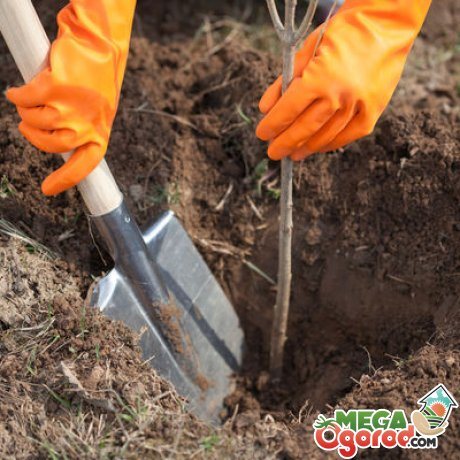

In order for the apple tree to begin bearing fruit faster, the young plant has to be transplanted several times:
- The first transplant is from a nursery to a container with earth. Placing in a large pot or box will help form the strong taproot needed for the tree to survive.
- The second transplant is carried out after the first year of the plant's life: the grown tree must be placed in a larger and deeper container. At the same time, the root bends and gently turns to the side.
- The third, last transplant is carried out when the seedling is ready for planting in the ground.After that, you will need to constantly take care of watering and fertilization, as well as provide the young tree with protection from the cold.
With each transplant, you need to try to preserve the root system as much as possible, it depends on how quickly the plant takes root in a new place.
It is important to choose a variety that suits the climatic conditions. If you, for example, choose southern varieties, in temperate climates they will constantly suffer from a lack of sun and heat, this will ensure slow growth. Seed material is not difficult to find, but it is important to choose only the healthiest seeds, which are guaranteed quick germination.


